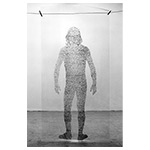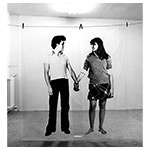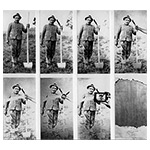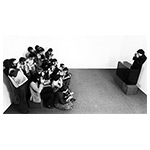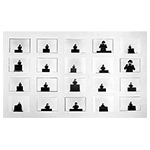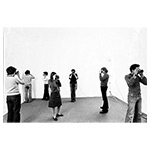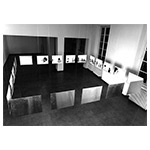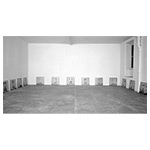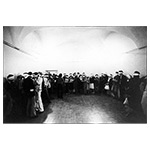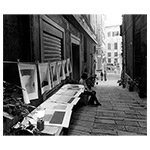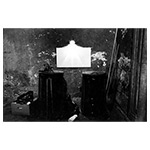Photography is an instrument constantly used by Pistoletto, from 1962 to the present day, for the realisation of the Mirror Paintings, to whose section of this site we refer for the reasons and modalities of its use in this sense.
During the 1970s Pistoletto instead produced a series of actions and works in which the phenomenology of the photographic process was specifically investigated.
In 1973, he created Self-Portrait of Stars (Autoritratto di stelle), a work consisting of the silhouette of the artist's body, obtained from a life-size printed photograph, filled with a great quantity of stars, taken from a photograph of a galaxy obtained by the telescope of the famous astronomical observatory of Monte Palomar. The work presents a union of microcosm and macrocosm, individual and universe, finite and infinite, void and full, instant witnessed by the photograph and eternity to which the life of the stars refers, activating that dynamic of opposite polarities that the artist identified with his Mirror Paintings and that remains a constant in his work and theoretical reflection.
In 1975 he created The Peasant (Il contadino), a work consisting of eight panels in which he subjects a photograph to successive physical, pictorial and photographic interventions. For an analysis of this work, see the text of the same name written by Pistoletto on the occasion of its first presentation, held at the Künstlerhaus in Graz in 1975.
Also in 1975, he made The Conference (La conferenza) and Rays of People (Raggi di persone). In the former, a lecturer and his audience of twenty people photograph each other. The lecturer gets one photo of a group of twenty people. These get twenty different photos of the same person. In Rays of People, on the other hand, twenty people, arranged in a room, photograph each other. The resulting twenty photographs are displayed, at eye level, along the four walls of a room, documenting the simultaneous gaze of all participants. For Pistoletto, The Conference and Rays of People represent two opposite modes of relationship. The Conference "is a photograph of power: the entire audience is concentrated in the person of the speaker, while the person of the speaker is multiplied by the number of people in the audience. The lecturer can be the speaker in the name of god and the audience all the people kneeling before god. The speaker can be the dictator and the audience can be the people listening to him. In this case, it is clear how the relationship between the two elements, politically conceived, produces a condition of dominance and subjugation. Quite different is the democratic attitude, which is expressed in the will, exercised by each person, to understand and be understood by every other, as represented in a work of mine in which everyone photographs each other. In this sense, a chain phenomenon of mutual projections and understandings is generated. The trinamic effect of the interpersonal relationship thus radiates into society, producing a diffuse and omniteist democracy."
(Pistoletto, Ominiteismo e democrazia, Chiarelettere, 2017, pp. 76-77)
In 1977 he produced The Spectators (Gli spettatori): on the 26th of January, around forty people were invited to one of his exhibitions at Galleria Giorgio Persano in Turin and were photographed looking into the camera. This photo was published in the information bulletin of the Samangallery in Genoa under the title The Spectators, accompanied by a short text by Pistoletto. The spectators of the exhibition, having become part of this new work, can thus see themselves being watched, spectators of themselves.
On 7 June of the same year, as part of the Incontri internazionali d'arte, at Palazzo Taverna in Rome, he performed Dietrofront. In an exhibition space where no object is present, a piece of cloth is torn and divided among those present, who are invited to use it to blindfold themselves. After a few minutes, during which the windows are darkened and the light switched off, so that the camera lens that could have documented the event also remains blind, the action ends. Outside the building, a drawing sheet was simultaneously placed near the rubbish cans, illuminated and bearing the inscription "Work for posterity. May your work not be visible today."
In October 1977, at the Samangallery in Genoa, he held an exhibition entitled High is Low, Low is Hig, Inside, Outside (L'alto in basso, il basso in alto, il dentro fuori). Inside the gallery are placed chairs and tables, whose legs, stretched by means of long branches, reach up to touch the ceiling, while a light bulb goes down to touch the floor. On the gallery walls, however, no works are exhibited, but the same walls and gallery interiors are photographed, and the photographs, printed on canvas, are displayed on a stall located outside. An extensive retrospective exhibition was dedicated to the role of photography in Pistoletto's work, entitled Michelangelo Pistoletto and Photography, presented in 1993 at the Fundação de Serralves in Porto and at the Witte de With Art Centrum in Rotterdam, to the catalogue of which we refer for a more in-depth look at this aspect of his work.
